

Nuclear fusion and nuclear fission result in a mass change, Δm, between the starting and end products. The loss of mass produces energy E = Δm c2, where c equals the speed of light. As a consequence of this Einstein relation, the mass of 1 kg can be converted into an energy of about 9×1016 J or 25×109 kWh. This is equivalent to burning 3 million tons of coal. The production of electrical energy by nuclear fission is widespread, while nuclear fusion is still under development.
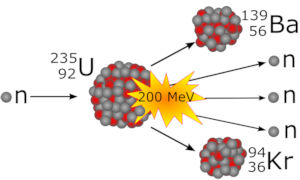
Uranium fission starts with absorption of a slow-moving neutron by the non-stable isotope U-235. The obtained U-236 splits into Ba-139 and Kr‑94 and releases three free neutrons. The mass defect of about 0.2 u (unitary atomic mass units) is converted into an energy of about 200 MeV (figure at right). We have u ≈ 1.66×10−27 kg, and the atomic energy unit electron volt, eV, is about 1.60×10−19J.
According to the World Nuclear Association (October 2024), there were 439 nuclear fission power plants in operation worldwide, 67 under construction, and 87 in the planning stages. America’s 94 operable reactors generated 19% percent of the nation’s electricity in 2023. For other countries it varies between 0%, e. g. in New Zealand, and 65% in France, worldwide in average meeting 9% of the world's 2023 electricity demand.
There are two main concerns about nuclear power plants: waste storage and possible meltdown. Nuclear power plants also produce radioactive waste; for example, a 1-GW nuclear power plant produces 300 kg of the α-emitter plutonium, which has a half-life of about 24,000 years, see Environmental Risks. The present ways for disposing such waste are not satisfying. One acceptable solution would be the complete reprocessing of all radioactive waste and nuclear transmutation of long-lived fission products. However, developments in that area have not progressed extensively.

The picture to the left is the
Gundremmingen Nuclear Power Plant in Germany which was orderly shut down at the end of 2021.
The two blocks of the power plant accounted until 2017 for about 30% of the electricity generated in Bavaria,
and prevented annual emissions of 21 million tons of carbon dioxide
that would be required by comparative fossil fuel power stations. The power plant was shot down,
in order to redcuce nuclear risks. Several catastrophic scenarios could take place in this and
other nuclear power plants. One scenario is if the boiling water reactor fails at removing the residual heat,
causing the fuel to heat and core structures to melt (Environmental Risks).
In the worst case, the hydrogen can ignite, resulting in an explosion that could destroy the foundation
and cause groundwater contamination. The possibility of terrorist threats and disasters such as
earthquake, tsunami and hurricane increase such fears. The last disaster was the
Fukushima Daiichi
nuclear disaster following the Tōhoku earthquake and tsunami on 11 March 2011.
Germany shut down its last nuclear power plant in April 2023, while there are currently
94 reactors in operation in the U.S. The U.S. Department of Energy (DOE) has commissioned a
study that recommends the development of new nuclear reactors
in order to achieve the long-term climate goals. Another study
with extensive literature references also addresses the waste problems of modern nuclear fission reactors.
Nuclear power plants of the next generation have made no progress on waste disposal, but there have been advances to prevent meltdowns. Third generation reactors are working or under construction, the fourth generation is under development. A third generation pressurised water reactor (PWR) has been designed and developed by Électricité de France and Siemens. The name of the design is Evolutionary Power Reactor (EPR). The first operational EPR unit started in December 2018 in China. The second is expected to begin operation in 2019. The AP1000 was designed and sold by Westinghouse Electric Company. The first AP1000 began operations in China in June 2018. There are currently 6 reactors working, 6 are under construction and 19 are planned.
At the end of 2020, the Advanced Reactor Demonstration Program of the U.S. Department of Energy (DoE) supported ten U.S. teams with $210 million to mature their technologies and demonstrate their reactors. The goals are firstly test, license and build operational reactors within 5−7 years, secondly solve technical, operational and regulatory challenges to support demonstration within 10−14 years and thirdly solidify concept to mature technology for potential demonstration by mid-2030s.
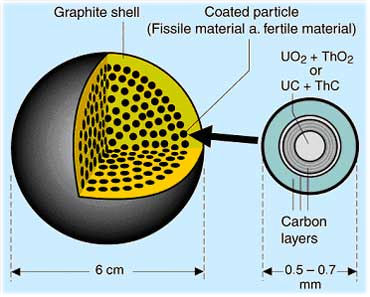
One of the supported projects is a sodium-cooled fast reactor including a molten salt energy storage system made by TerraPower. Also the company X-energy was chosen by the DOE as a recipient of a grant totalling between $400 million and $4 billion over the next 5 to 7 years for developing the pebble-bed reactor (PBR) type Xe-100. For this very high temperature reactor (VHTR), a 13-MW experimental reactor AVR was operated in Jülich from 1967−1988, and a nuclear power plant with a 300-MW-reactor was operated from 1983−1989 in Hamm-Uentrop.
The pebble-bed reactor is characterized by a low uranium consumption, low heat generation, and the potential for district heating. Using helium gas as a coolant and graphite as a moderator allows for temperatures of 300−950 °C. The enriched fuel cores with 8% fissile material have a diameter of only 0.5−0.7 mm. They are coated with three layers of silicon carbide and pyrolytic graphite that have an extremely high efficiency for fission products at high temperatures (1600 °C). As shown in the Euronuclear figure to the right, the small spheres are pressed in a fuel element-graphite matrix with a diameter of 6 cm. If the permeation of oxygen is prevented, the fuel does not melt after the loss of cooling. Steam with a temperature of 530 °C and 200 bar pressure can be generated in an additional generator. Using a gas turbine and helium at 900 °C can create efficiencies up to 45%.
Unlike those for nuclear fission plants, there are no expected problems procuring or disposing of fuels for future fusion power plants. Waste from nuclear fusion, such as the reactor materials after disassembling, generates dangerous radiation as well, but 99% of the waste has a half-life of less than 10 years. In the 1960s, it was believed that at the end of the 21 century much of the energy generated would come from nuclear fusion. However, at the end of the last century it was found that turbulent processes in plasma give rise to energy and particle losses and reduce the energy confinement time in which plasma can be kept stable. Thus the first nuclear fusion plant is not expected before 2030.

The fusion of a deuterium and a tritium nucleus creates an alpha particle, a neutron and 17.6 MeV energy. The latter should sustain the plasma to reaction temperature, so that escaping neutrons, which absorb 80% of the fusion energy, heat the water which drives the stream turbines. The Fusionforenergy figure to the left shows the fusion reaction
The main problem with fusion on Earth is the extreme reaction temperature. The reaction plasma must remain at more than a hundred million degrees on a stable position away from any material. The sun does not have this temperature problem. The main process in the sun is the proton-proton chain reaction. First two hydrogen nuclei 1H+ (protons) fuse into a deuterium nucleus 2H+, releasing a positron e+ and an electron neutrino νe as one proton changes into a neutron:
The resulting deuterium nucleus reacts with another proton, resulting in the light helium isotope 3He2+ and a gamma ray photon γ:
In the reaction of the pp I branch helium-4 comes from fusing two of the helium-3 nuclei produced:
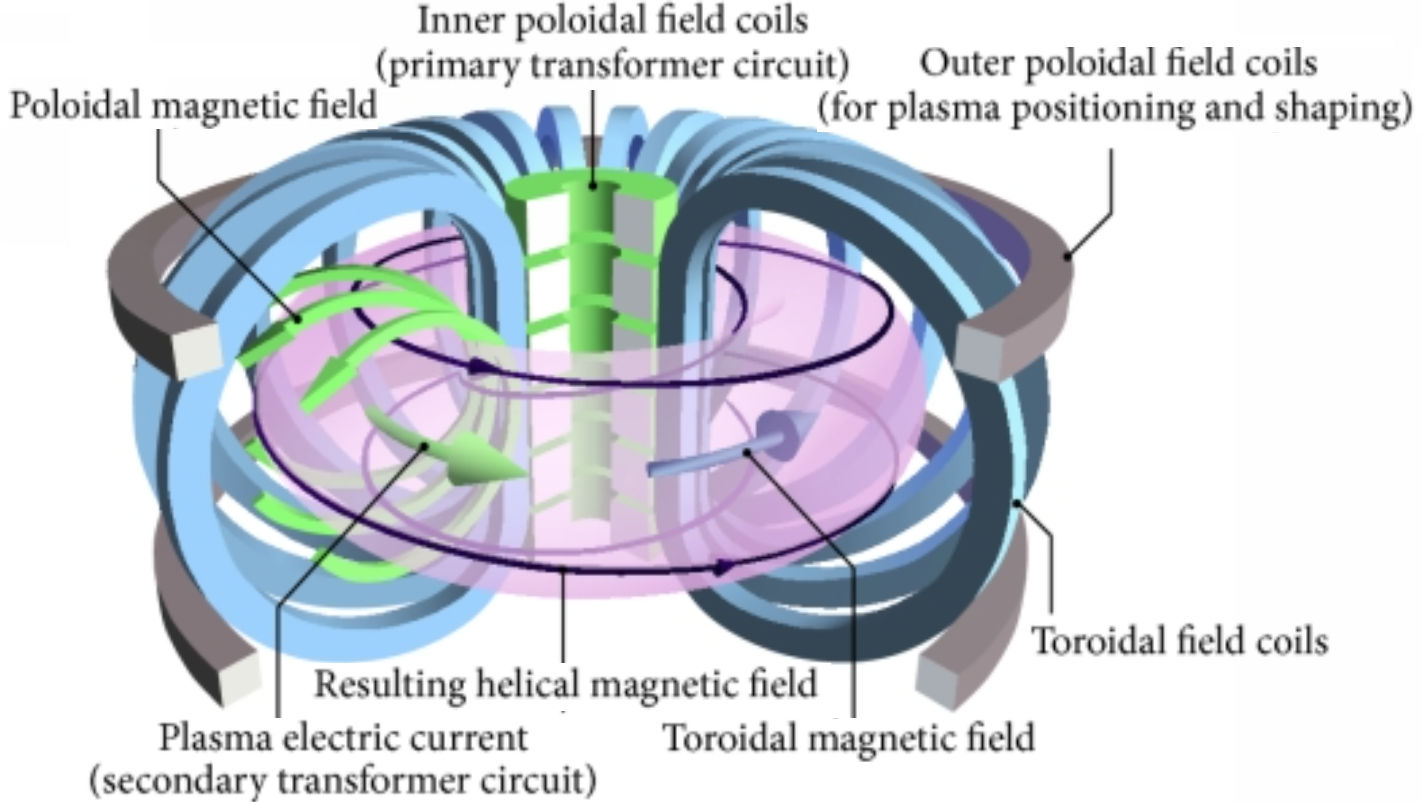
In order to hold the reaction plasma in a stable position far from any material on Earth, three fields are superimposed in a Tokamak (russ. тороидальная камера в магнитных катушках). The picture on the right shows the super-conducting magnetic coils and the three fields of the rose plasma current, of the blue toroidal field coils, and the green transformer circuit.
The fusion product, Tnτ, consists of the temperature T, particle density n, and energy inclusion time τ. Since 1983, the Tokamak experiment JET (Joint European Torus) from the European Fusion Program has been in operation in Culham, England.
The fusion product of the JET is only a factor of 5 under the goal value for a power plant. This is shown in the image to the left, taken from a report of the Max Planck Institute for Plasma Physics. The ignition diagram shows the progress of fusion research since 1960. The fusion product is given in the unit 1017 particles per cubic centimeter × seconds × degrees Celsius.
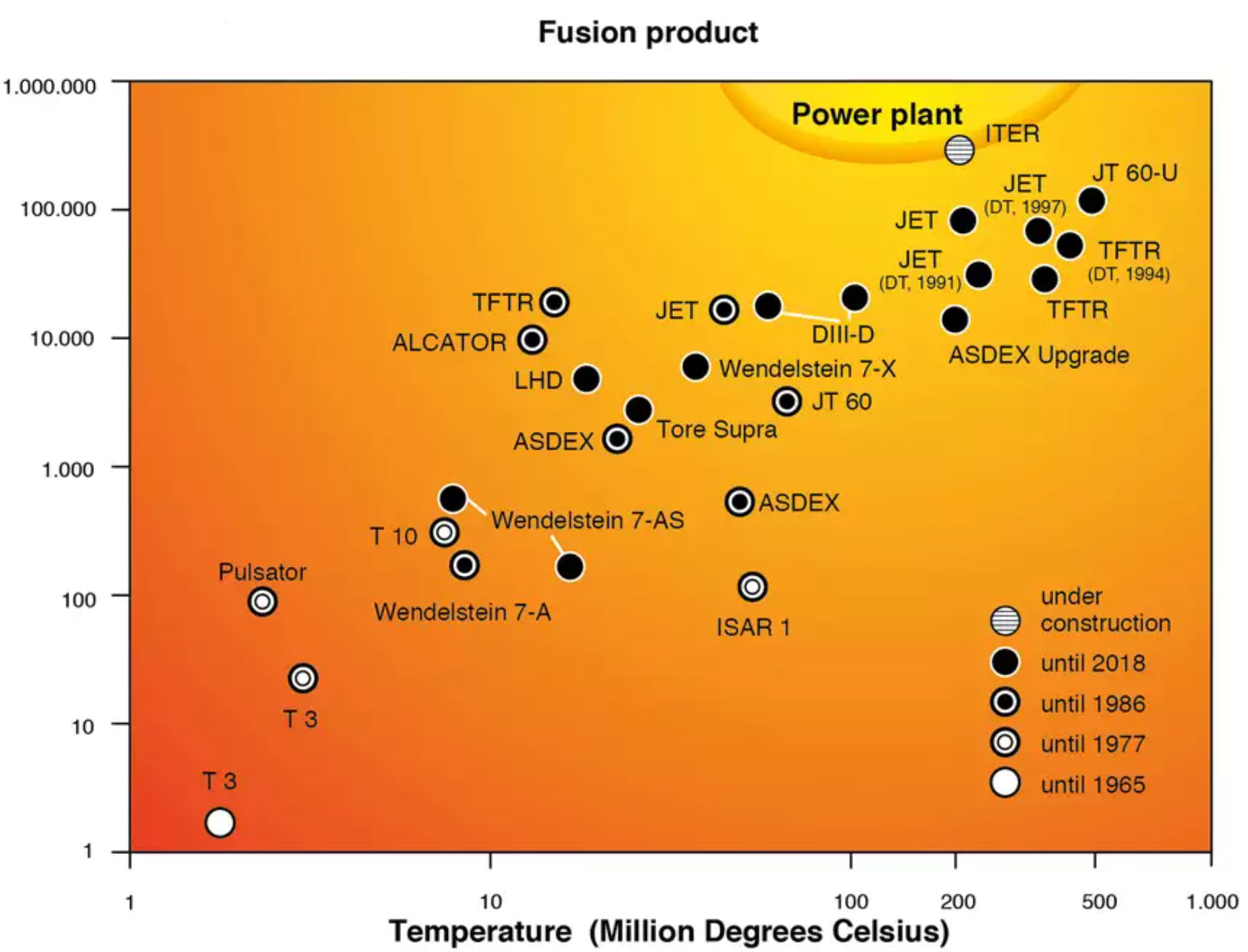
The fusion energy gain factor, usually expressed with the symbol Q, is the ratio of fusion power produced in a nuclear fusion reactor to the power required to maintain the plasma in steady state. At the end of the last century, a value for Q of 0.5 was reached, meaning that twice as much energy is consumed than is obtained. As early as 1988, the United States, Russia, Japan, China, South Korea, and the Euratom started the project ITER (International Thermo-nuclear Experimental Reactor) and, in 2005, began building the project in Cadarache, France. Now the giant tokamak reactor for 0.5 GW, 500 s pulse length, and Q = 10 is under construction. The estimated costs have increased above 10 billion Euros.
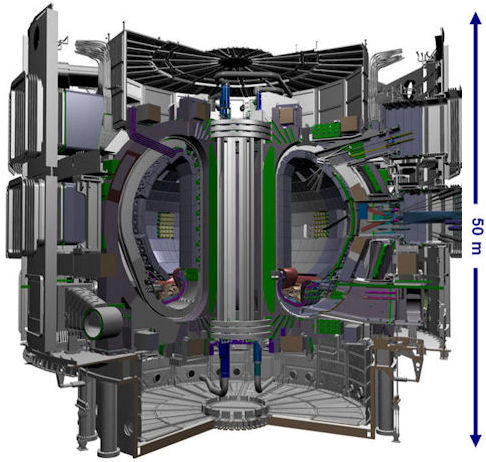
It is currently planned to realize a deuterium-tritium reaction in 2039. The figure to the right shows a section of the plasma ring. The superconducting coils must be cooled to 4 K in a cryostat containing liquid helium. It is to be expected that predictions about real possibilities for generating electrical energy will only be available at the end of the next decade. ITER is the most promising project to make progress in the technical realization of direct energy production through fusion devices on Earth.
In addition to the Tokamak, another energy project, the Stellarator is under development. It was called the “Stellarator” to emphasize its similarity to the fusion processes in a star (latin stella). This type of a fusion machine was introduced in 1951 at the Princeton Laboratory for Plasma Physics, and would operate on a different principle than the tokamaks. Tokamaks create a part of the magnetic field (for enclosing the plasma) by means of the strong electric current flowing in the plasma, as shown above. But stellarator-type reactors use only external fields for the plasma inclusion. It makes the construction more difficult since the magnetic cage is produced with a single coil system without a transformer. But it also makes stellarators suitable for continuous operation, whereas tokamaks without auxiliary facilities operate in pulsed mode.
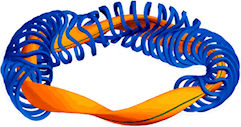
The stellarator Wendelstein 7-X has been in construction since 2005 in the Institute of Plasma Physics of the Max Planck Society at Greifswald and the first plasma could be produced at the end of 2015. Wendelstein uses an optimized magnetic field that overcomes the difficulties of earlier stellarator concepts. The experiment aims to demonstrate that a power plant can work on the basis of a continuously operating stellarator. The figure to the left shows the sophisticatedly shaped coils (blue) and the plasma.
Inertial confinement fusion is a process where nuclear fusion reactions are initiated by heating and compressing a fuel target in the form of a pellet. In contrast to the magnetic confinement of the fusion plasma in the tokamak or stellarator, the inertial confinement of deuterium-tritium fuel holds only for a few nanoseconds. During this short time the mass inertia ensures the cohesion of the plasma. The hydrogen bomb functions on this principle. Research in the field of inertial fusion, therefore, can be used for military purposes, and research institutions are supported by the national military budget.
The National Ignition Facility (NIF) was built from 1997-2009 at the Lawrence Livermore National Laboratory in Livermore, California. The 192-beam NIF laser system can fire 1 megajoule of laser energy at a peppercorn-size target located at the center of the 10-meter-diameter target chamber and trigger a nuclear fusion with a 500-terawatt-flash of ligh. The plasma collapses at a rate of 1.5 million km/h and can reach a temperature of 100 million degrees Celsius. At the end of 2022, the laser could initiate a (compared to the laser irradiation energy) higher energy production via nuclear fusion in the pellet. The progress of this project is regularly reported on a NIF page.
Laser Mégajoule (LMJ) is another large research project for inertial confinement fusion. The laser facility is located in Le Barp near Bordeaux, France, and belongs to the Commissariat à l'énergie atomique et aux énergies alternatives. The project began in 2002 and performed a first series of experiments at the end of 2014. Information about the efficiency of the inertial confinement fusion for energy production is expected from NIF and LMJ in the future.